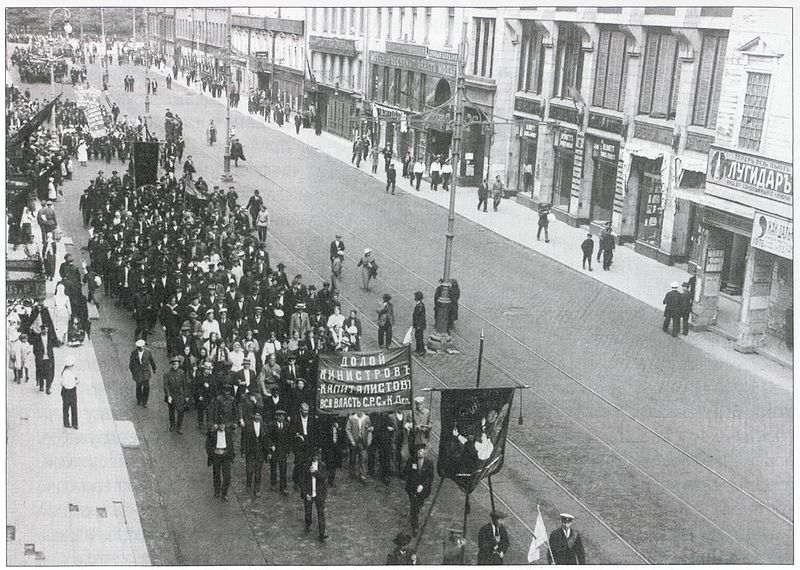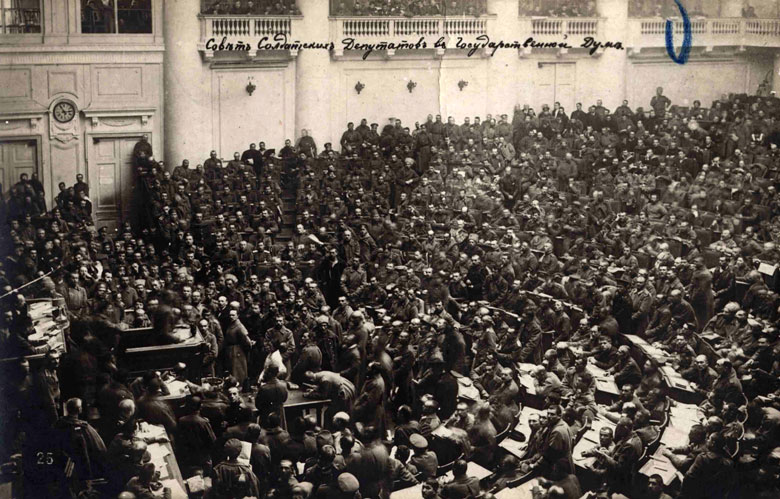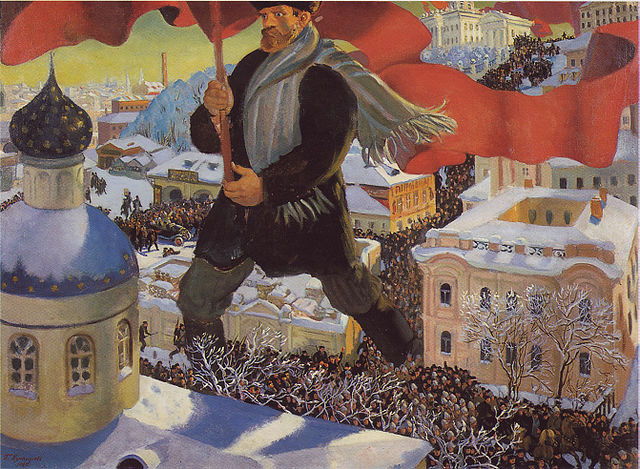In the second episode discussing the tumultuous year 1917 in Russia, we examine the reasons for the failure of the February Revolution (discussed in Episode 1). How did the Bolsheviks, a small party on the far left of the political spectrum that barely merited any notice in February, come to dominate the popular revolution during 1917? And how did the Bolsheviks manage to channel their popularity into the power to seize control of the government of the world’s largest country?
Guests
 Joan NeubergerProfessor of History, University of Texas at Austin
Joan NeubergerProfessor of History, University of Texas at Austin
Hosts
 Christopher RosePostdoctoral Fellow, Institute for Historical Studies, The University of Texas at Austin
Christopher RosePostdoctoral Fellow, Institute for Historical Studies, The University of Texas at Austin

Russia had had one revolution in 1917 (the “February Revolution“), and yet, it had a second a few months later. Why wasn’t the February Revolution the end of the story?
If we’ve learned one thing from the revolutions of the 19th, 20th, and now 21st centuries, it’s that it is much easier to overthrow a bad government than it is to construct a new one. If we look at the “classic” revolutions of France, Russia, and China, what the revolutionaries are fighting for—egalitarian societies, democratic governments—are rarely the result. Chaos, conflict, uncertainty; more violence are much more common, and often led to centralized, authoritarian governments. We can look recently at Iraq and Egypt to see how hard it is to construct a new, stable government after a revolution.
When we left off, the Romanov dynasty had been deposed. So, what happened next?
After the overthrow of the 300-year-old Romanov dynasty, there was general euphoria and celebration all over the Russian empire. In Petrograd, which today is St. Petersburg, within 24 hours no signs of the tsarist order on the streets—statues were toppled flags lowered and burned, and the Romanov family crest—the double-headed eagle—were pulled down. There was literally celebration on the streets.
The problem was that, after the party, governing problems arose immediately. Who should rule in place of the tsars? It wasn’t clear; there was no set of traditional institutions that could easily take the place of these centralized powers. Who should decide who should rule? There was no clear answer to that question either. And how could these decisions be made in the midst of a war? Russia was in the midst of World War I, which had started in 1915 and would continue through 1918.
While politicians decided these questions, there were all sorts of practical, every day problems. Food still needed to be produced in the countryside and needed to be transported to people living in cities and it needed to be transported to soldiers at the front. People needed to work; factories in many places were in chaos themselves, and at a standstill. Soldiers, who were mostly untrained, recent recruits from the peasantry, many of them began trickling home from the villages in the hopes that the revolution would give them what they thought was theirs all along—the land.
Conditions around the vast Russian empire soon spun out of control. In less than a year, the moderates who led the movement to overthrow the tsar, were themselves overthrown. In October 1917, the most radical political group on the scene—the Bolshevik Party—predecessors to the Communist Party would come to power.
How did a party that no one took seriously in February 1917, a group so radical it was on the very far-left fringe of the political landscape—How did this party, the Bolshevik Party, come to power in October?
Related to this question is one more: was the Bolshevik revolution in October 1917 a coup carried out by a small group of fanatical, power hungry socialists or was it a popular democratic movement, supported by the majority of people?
We can answer those questions by looking at the key crises of the year 1917 and see what the Bolsheviks did during those crises.
Let’s start in March 1917, right after the tsar abdicated and left a power vacuum in Petrograd. The first crisis is a crisis of governance. Moderate liberals immediately set up a Provisional Government in Petrograd, the capital. Why Provisional? Because as liberals they believed government should be based on the will of the people, that representatives of the people should write a constitution that would lay out the basic rules for governance and for civil rights, and then they should hold elections to create a new government. Problem was, in March 1917, the country was at war and the people in power didn’t think they could withdraw from the war and abandon their allies, or stop to hold a constitutional convention. So they created an interim “Provisional Government” until they could end the war.
So, you mentioned that this was a government of moderates and liberals. Obviously, retrospectively, we know that the socialists would play a major role in what was to come. So, where were they in all of this?
At this point, the political system was dominated by liberals, moderates, and some conservatives. Although there were socialists in the Tsarist government, they played a much smaller role and really, the radical parties were out on the streets organizing workers, organizing peasants, but they didn’t as large a role in the government. At this point, though, they decided that it was their turn to pick up some of the power that was lying around in the streets.
Some political leaders who represented peasants and workers didn’t trust the Provisional Government to respect the rights of the majority of the people, and most of those people wanted an end to war and some signs of egalitarian distribution of power, now not later. Most of these leaders were socialists, which were by far the most popular political parties of the time, even though they’d been out of power up until this time.
Socialists followed the theories of Karl Marx who claimed that a socialist revolution could only take place after the liberals and capitalists had been in power long enough to establish a rule of law, and that the workers would be impoverished, and wealth would be concentrated in the hands of a small minority of people. So the socialists weren’t ready to come to power yet themselves—they didn’t believe that it was their time to take power—but they didn’t want to cede all power to the liberals either. So they set up a kind of watchdog institution called the Soviet. “Soviet” is the Russian word for “council.” These councils of peasants and workers and soldiers’ representatives had sprung up earlier, in 1905, and they sprang up again in 1917. The Soviet in Petrograd was a watchdog for the Provisional Government. The result was what we call Dual Government. The Provisional Government was too weak to prevent the Soviet from forming, but the Soviet was too weak to come to power now—the result was a kind of gridlock that added to the chaos of life in 1917.
As all of this was happening, the Soviet passed something called Order No. 1. It was their first act in 1917, and it took place in February. Order No. 1 called for the democratization of the military. This was both incredible popular, and incredibly disastrous for the military. It meant that, among other things, no orders could be issued without being approved by the non-officers. So, officers’ orders were subject to so-called democratic approval. And, of course, anyone who knows how the military functions knows that this is a recipe for disaster!
So, where were the Bolsheviks in all of this?
At this point the Bolsheviks were too radical to play prominent roles in the Provisional Government, which they didn’t really want anything to do with. There were representatives of the Bolsheviks in the Soviet, although they weren’t the majority at the beginning of 1917. And their leader was still in exile.
Vladimir Lenin, the acknowledged leader of the Bolshevik party, arrived back in Russia in April 1917. At that point, he made a speech that was barely noticed at the time but, in retrospect, was one of the most important events of the year. At the time, this speech shocked even his closest supporters. He said that the Bolsheviks didn’t need to follow Marx’s historical prescription; we’ve waited long enough for the liberals and capitalists, there’s no reason not to seize power now. “All power to the Soviets!” was his slogan. Lenin recognized a power vacuum when he saw it, and he realized that it would be possible to take power sooner, rather than later.
“All Power to the Soviets!” turned out to be a popular slogan. Soviets sprang up all over the country, replicating dual government in cities and towns all over the Empire. In Petrograd all sorts of grass roots institutions also sprang up in addition to the Soviets. The Provisional Government was dragging its feet on creating democratic government, on instituting workers’ control of factories, and on instituting land reform, so ordinary people began holding elections for factory councils and neighborhood militias. Socialists dominated these local elections from the very beginning.
To sum up what’s going on, we’ve got the socialists gaining wild popularity, we’ve got a very unpopular war going on, and we have two—if not many more—governments forming around the country. So, how did the Provisional Government attempt to deal with this?
The Provisional Government decided that the best thing to do would be to try and bring an end to the war. They believed that the Russian military was still in a pretty strong position—by the end of 1916, Russia had actually been winning the war on their front. In June 1917 the Provisional Government launched an offensive against Austria and its allies in the hopes of a decisive victory to make it possible to end the war. It was a carefully planned offensive, but it turned out to be a disaster. The army was in much more chaos than the Provisional Government realized, and so the Russians lost that war.
This undermined the Provisional Government in the eyes of the people. The Provisional Government had to reform; it threw out many of its more liberal members and drew in many moderate socialists. It was now led by Alexander Kerensky—who was a socialist—whose goals were to maintain order, to organize food supply and ultimately to enact land reform. Like many in the government, Kerensky favored land reform to give peasants more land that had belonged to the aristocracy, but he didn’t want to engage in major land reform in the midst of war and urban chaos.
But the war was so unpopular that, during the summer of 1917, soldiers were deserting from the ranks by the thousands. What had been a trickle in February became a flood during the summer as soldiers not only deserted the front but came home to seize the land they considered their own. At this point, the only political party outside the power structure was the Bolshevik party, who were also the only party to encourage peasant land seizures. Lenin made speeches all over the country calling for peasants to seize land. We can look at these speeches in two different ways. One, it was responding to the will of the people and politically it was a brilliant move, but, on the other hand it was a highly irresponsible contribution to illegal and disruptive land settlement, that in fact all political parties supported, but that the more responsible parties felt needed to be planned and carried out in a more organized fashion. The upshot of this is that it won the Bolsheviks a lot of support.
In cities, workers were taking over factories or at least electing committees to assert “workers control;” one of the other promises of the February revolution was that the workers would be able to control their destinies in the factories. “Workers control” is a pretty vague notion that didn’t have much power in practice, but that didn’t stop the workers from holding elections. The elections increasingly gave legitimacy to workers who identified with and supported the Bolshevik party. Again, this was the only party not tarnished by participating in the Provisional Government and the disastrous June Offensive. The Bolsheviks seemed to be the party that truly supported the peasants and workers, by far the majority of the population.

In July the Bolsheviks thought they might have enough support to call for all power to be turned over from the Provisional Government to the Soviets. At the last minute, Lenin and the Party decided that didn’t have enough power, so they pulled out of a planned popular demonstration at the last minute. The demonstration went ahead anyway, and it appeared that it was associated with the Bolsheviks, but it was successfully suppressed by the Kerensky government, who arrested most of the Bolshevik leaders and claimed that the Bolsheviks’ only goal was to disrupt the legal government of the country. That actually wound up tarnishing the Bolsheviks’ reputation among many people, including the workers who participated and felt that they had been hung out to dry by the Bolshevik party.
This was relatively short lived. The next major crisis in August gave the Bolsheviks even greater credibility with the mass of people.
And how did they accomplish that?
Things by this point were really chaotic. It’s summertime, we’ve got peasants seizing land, we’ve got workers demonstrating and trying to seize control of factories, there’s problems with food supply, there’s problems with the military. In such chaotic circumstances it’s not unusual for a popular military hero to offer and succeed in bringing order back to society. Lavr Kornilov was just such a popular war hero, but his attempt to bring troops into the capital was seen by most people as an attempt to take away the democratic gains of the revolution. Kerensky had to call on the Soviet and the Bolsheviks to protect the city from a military counter-revolutionary coup.
This firmly restored Bolshevik popularity in the capital and also around the country, as they were seen to be the only people protecting the democratic revolution from counter revolution. By September the Bolsheviks gained a majority in the Petrograd Soviet. Kerensky tried to rally support for the Provisional Government but rumors spread that he had been secretly negotiating with Kronilov to take over Petrograd, and those rumors doomed him and his government.

How did the Bolsheviks use this crisis and surge in popularity to bolster their power?
Lenin began lobbying hard in his own party to seize power now. He saw that the Provisional Government was really falling apart. He called for all power to be taken in the name of the Soviets. The All-Russian Congress of Soviets was scheduled to meet in Petrograd in October. By the fall of 1917 the Bolsheviks had the support of local factory committee—in fact, they were the majority on many of these committees by this time—and they had the support of the peasants. The Provisional Government under Kerensky that was severely weakened. During the Kornilov affair, another major Bolshevik leader, Lev Trotsky, had formed an armed militia called the Military Revolutionary Committee to protect the revolution from the military counter coup. So they had everything the needed. The only thing Lenin didn’t have was the support of the leadership of his own party. But by the end of October, the whole of the Bolshevik party was in favor of seizing power.
On the night of October 24-25, while most people in Petrograd were living their lives, having dinner, going out to the theater, going out to restaurants, walking around the city, the Military Revolutionary Committee was busing taking over key Petrograd institutions: the railroad stations, the telegraph. It was all pretty peaceful. Most people in Petrograd didn’t even notice. On October 25, the Bolsheviks broke into the Winter Palace (now the Hermitage museum) where Kerensky and his government were and took over the government.
Kerensky managed to escape, much to the chagrin of the Bolsheviks. He lived first in Europe, and then lived out the end of his life at Stanford University.
The congress of Soviets ratified the transfer of power, but the majority were socialists, not Bolsheviks. They assumed power would go to the Soviets. Lenin had other ideas, and seized power for the Bolsheviks alone, even though they didn’t have a majority in the All Russia Congress of Soviets. This was a dictatorial move that had nothing to do with the egalitarian hopes that brought the Bolsheviks into power, and it led directly to a long civil war that would follow, beginning in 1918.

So, going back to the question posed at the beginning of the episode: how did the Bolsheviks come to power? Was it a coup carried out by a small, far-left fringe group seizing power, or was it a popular democratic movement?
Vladimir Lenin was a brilliant political strategist. He understood very well where power was being held in 1917, and where its weaknesses and strengths were. He kept himself outside the Provisional Government so that he and the Bolsheviks weren’t tarnished by being part of an ineffective government during a year of chaos and revolution, and he sought the support of popular groups. He supported everything that the peasants and workers had wanted out of the revolution, and, as the majority of the population, that support was very important.
As far as whether this was a coup, there’s an historian who said that power was lying on the streets in October 1917, and any group of determined men could just pick it up—and that that’s what Lenin and the Bolshevik leadership did. And there is some truth to that: there was power laying around in the streets, and Lenin persuaded the leadership of the party to pick it up. But they couldn’t have done it without the events of 1917 and without the popular support among the Soviets and the peasantry.